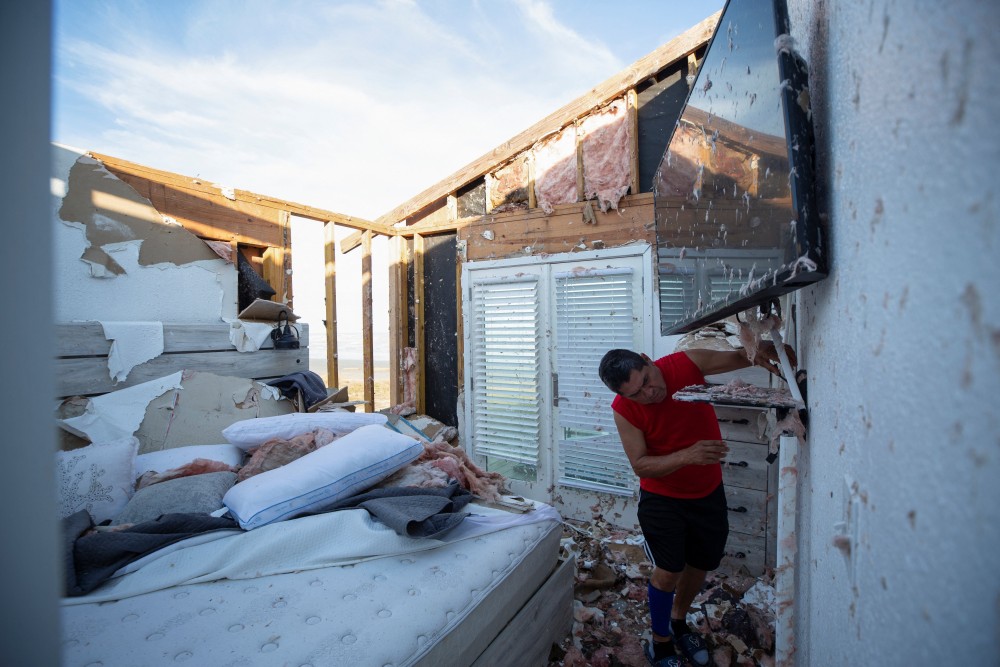
By James Ramos
HOUSTON (OSV News) — Close to a foot of rain fell in just under 12 hours in parts of the Greater Houston area as Hurricane Beryl pushed into the southeast Gulf Coast of Texas when it made landfall near Matagorda, Texas, in the early morning hours of July 8.
Throughout many Houston-area neighborhoods, the loud popping — followed immediately by flashing lights — of transformers and their fuses exploding became as common as the buzzing cicadas as Beryl’s 40-80 mph winds whipped the state. With each loud crack, residents anxiously watched their lights flicker, and then suddenly turn off. By 12 p.m. that day, more than 3 million homes and businesses were without power.
Beryl, which at its peak was a Category 5 storm and the earliest in the season on record, first lashed Grenada July 1 with Category 4 hurricane winds of 150 mph and then slammed into Mexico’s Yucatán Peninsula July 5 as a slightly weaker Category 2 storm.
The storm forced many businesses and parishes to cancel events or close July 7 and 8 in preparation for its Texas landfall, including a large young adult event with Cardinal Daniel N. DiNardo, archbishop of Galveston-Houston.
In Freeport, where St. Mary Star of the Sea Parish serves many oil and gas workers employed at the nearby petrochemical refineries, residents were surprised by Beryl’s intensity as a Category 1 storm. Wind gusts of 94 mph flipped 18-wheelers and RV homes, knocking down billboards and tearing apart roofs and walls.
Hunkered down in his beachside home where he rode out the storm in the bathroom with his dog Shiloh, Jimmy Beal, a 35-year resident of nearby Surfside Beach, shook his head as he told Austin’s KXAN-TV that he thought he could handle the storm.
“I didn’t think we were gonna make it,” he said, after the storm moved north towards Houston.
“Thank God, I did a lot of praying last night, trust me. … I’ve never seen the wind blow that hard here. Never,” he said. “That was no ‘Cat 1.’ I’ve been through hurricanes before. I ain’t never felt this house shake like that.”
Beryl hit Houston just 50 days after an unexpectedly vicious wind and thunderstorm, known as a derecho, slashed Texas with 100 mph winds, shattering some 4,000 windows in downtown Houston. Tarps remaining from that mid-May storm were seen torn off open roofs by 85 mph winds and fences that were just replaced were knocked to the ground.
Beryl’s rains and flooding pushed bayous and rivers past their banks and into nearby streets and highways, making parts of several major Houston highways into sudden vast lakes.
Stranded drivers prompted high water rescues around the region. Drone footage showed first responders using a firetruck’s ladder to reach a man trapped on his truck surrounded by rapidly moving, white-capped water on a major Houston freeway.
Beryl’s arrival was the first time Houston took a direct hit from a hurricane since Hurricane Ike devastated the region when it made landfall on Galveston Island in September 2008. Ike brought a storm surge of 7-12 feet. The surge destroyed the Seafarers Center, home to one of the Archdiocese of Galveston-Houston’s port ministries, and the historic St. Mary’s Cathedral Basilica, both located just blocks from the island’s popular Strand Historic District. The storm forced the archdiocese to close the Cathedral Basilica for a six-year restoration effort.
Two years after Ike, the archdiocese opened Our Lady by the Sea Chapel and Catholic Center on Crystal Beach in September 2010, which sits 18 feet above sea level, replacing a previous parish and mission that were both destroyed by Ike.
Multiple deaths have been attributed to Beryl, with at least eight in Houston. Among them was one person who drowned in his car on his way to work at the Houston Police Department; two others were killed when a tree fell on their homes, and another died in a house fire.
According to reports, Hurricane Beryl’s initial massive size, followed by explosive growth to a Category 5 hurricane on July 2, made it the most powerful hurricane ever observed this early in an Atlantic hurricane season. Only one other Category 5 storm, Hurricane Emily in 2005, was known to have ever formed in July. Weather officials said “exceptionally warm ocean temperatures” were effectively rocket fuel for Beryl’s rapid development.
As Beryl moved through east Texas bound for the Midwest and Canada, weather officials issued a heat advisory for southeast Texas residents for July 8, warning of soaring temperatures reaching heat index values of 105 degrees Fahrenheit in south Houston.
Beryl was the second named storm of the 2024 hurricane season and had major impacts on Jamaica and the Cayman Islands as it headed to Mexico before making landfall in Texas.
Early reports were that the islands of Carriacou and Petite Martinique, which are part of Grenada, may have taken the brunt of the destruction when Beryl struck the island.
In Miami, the archdiocesan Catholic Charities agency had set up a portal for donations, while the Baltimore-based Catholic Relief Services noted that it had a field person working in Grenada still assessing the scope of the damage there.
In a July 4 message of hope and resilience, Bishop Clyde Martin Harvey of St. George’s, Grenada, urged Catholics to pray and come together to attend to each other’s needs.
“Out of the chaos of this disaster, come, and let us walk together to new places and dreams that never were,” he said.
